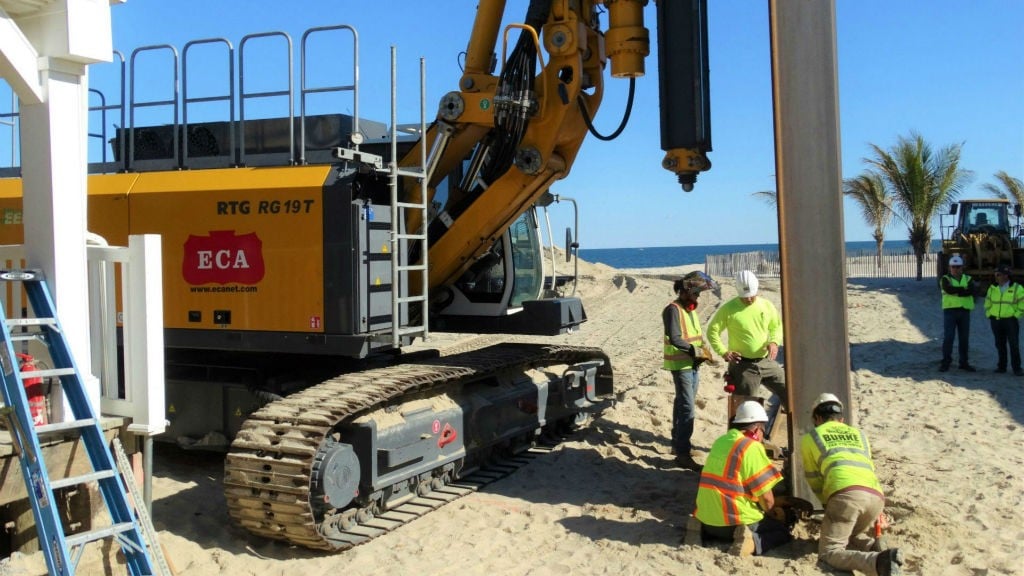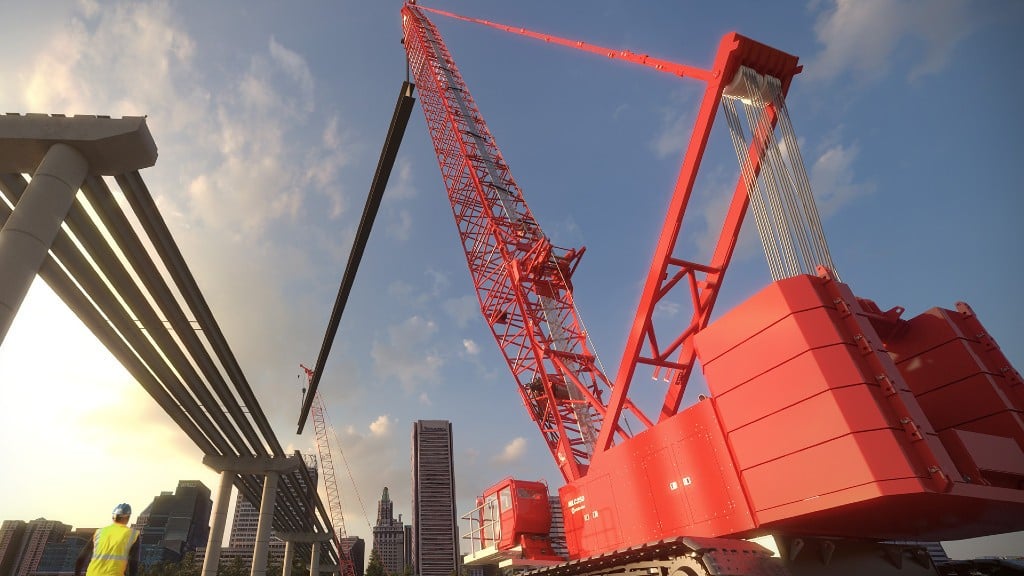How a heavy civil contractor took on its first pile driving project
Protecting a boardwalk and nearby homes takes fast learning and a powerful, quiet pile driving rig

Burke Construction Inc.'s first pile driving project was no easy task. The job at hand for this heavy civil contractor was to install a steel seawall, but this was no straight line of sheet piles in the middle of the beach.
Successful completion of the project would require the contractor to take on its first pile driving project and to learn and achieve adequate production with the RTG RG 19 T – one of the most sophisticated piling rigs in the world. Working around the inside and outside corners of the nearby boardwalk would only intensify the learning curve.
Jason Burke is the quintessential bold young contractor founder. His company is known for heavy civil work throughout Northern New Jersey, most recently having demolished the former Tappan Zee Bridge.
Asked if he had reservations about venturing into pile driving, he says, "Yeah, it was a bit scary. But so was taking on a job to demolish the entire Tappan Zee Bridge and we finished that six months ahead of schedule."
The fact that Burke's grand entrance into pile driving was the Point Pleasant Seawall is no coincidence. The contractor had previously installed well points feeding seawater to Jenkinson's Aquarium and also mobilized its large fleet of earthmoving equipment to clean up after Hurricane Sandy. The owner invited the firm to bid the seawall project as a result.
Burke, who admits that brand is an important factor when he buys and rents equipment, was unfamiliar with RTG, but he had done business with ECA and appreciated that the company stood by its products. After being awarded the seawall project, he came to ECA Philadelphia's Account Manager Steve Sigmund and asked for a recommendation. He ended up renting the RTG RG 19 T Pile Driver equipped with an MRV 150 AVM Silent Vibro in September of 2019.
Productive despite the learning curve
The RG 19 T is no entry-level piling rig. "We have a lot of experience with rock, sand, and beach work, but as far as piles, it's been very minor," Burke says. "Without that RTG rig, this probably would have been a two-contractor job because I would have hired somebody."
The RG 19 T had its work cut out with 801 two-foot 4 1/2-inch sheet piles supplied by Skyline Steel. Burke hauled the piles in from the Broadway entrance on the northern end and laid them out at their final destination.
On a mild November morning, the RTG piling rig was starting production on a short line of piles heading toward the ocean. Despite the proximity of the adjacent building, the operator was able to safely swivel 180 degrees to pick from a carefully laid out line of piles in the sand.
Burke used the RG 19 T to vibrate each 4-foot-9-inch-wide interlocked sheet pile into the beach, displacing 12,000 tons of sand in the process. Heavy equipment was used to spread the material evenly across the beach.
Careful measurement was critical, especially since the sheets were cold-rolled steel. "Every sheet gets measured," Burke says. "The extra give makes them a little easier to drive and put together but it also gives them the ability to roll a bit so you have to put a tape measure on every single one. We lock a clamp on the falsework beam and drive them so they stay right at four feet nine inches." Burke's hand measurement was more about diligence than necessity because the RG 19 T is equipped with a fixed leader that secures the hammer snugly to the mast, allowing it to drive straight piles with high crowd forces and torque.
Burke's crew worked from south to north. "We started at the hardest part and that was definitely a part of the learning curve," Burke recalls. "We had to go around three buildings and getting into the corners was very difficult because they were really tight."
Starting the wall in a jagged pattern also meant less productivity momentum up front. "We've done 1,200 feet of wall with inside and outside corners and we're already hitting 100 feet a day," he says, joking that he plans to dance a jig when the crew hits the straight run. "Once we get to this straightaway that (RTG) machine's going to do at least 150 feet a day."
Burke doesn't think 200 linear feet a day is out of the question for the RG 19 T, but he doesn't want to sacrifice quality either. Because these are exposed sheets, the crew is achieving 150 linear feet a day based on keeping the piles perfectly straight and plumb.
In fairness, Burke has no previous pile driving projects to compare productivity rates, but he has done the homework. He cites several contractor friends maxing out at 50 linear feet a day with crane-mounted piling hammers and recognizes that the RTG is tripling that production rate.
Although the RG 19 T is a complex piling rig, a standard heavy equipment operator can run it efficiently with some training and practice. ECA provided three days of onsite training to be exact. "He's picking up speed as he's getting better running it," says Burke, noting that neither his operator nor ground crew had ever worked with sheet piles.
Reduced vibration keeps neighbours happy
As you walk up the ramp from the street side of the boardwalk, it becomes apparent just how close the Burke team was working to stores and homes. And yet the sound of pile driving is barely audible between the storefronts.
The MRV 150 AVM Silent Vibro was key to avoiding disruption. This hammer achieved a reduction of 6 decibels from the previous model in 2017 with such features as encapsulation of the front section including the hydraulic motor; soundproofing of the spring suspension unit; soundproofing between spring suspension unit and clamping head; sheathing on all chains; and rubber coatings on all chain attachment points.
A seismologist remained on hand at all times conducting vibration monitoring properties near Burke's pile driving operation. He also documented the original condition of all homes along beach before work commenced. Store owners elected to conduct their own vibration monitoring to keep the project moving.
The Burke crew had just begun driving piles at the intersection of two stores in early November morning with 1,200 feet of wall driven to date. "The machine (RG 19 T) is only turned up to about 25 percent and it's driving 30-foot-plus sheets with ease without even triggering any alarm with the seismologist," says Burke. Although it wasn't required on this project, the RTG can deliver a maximum 31,473 foot-pounds of downward crowd force.
Burke will wrap up the Point Pleasant Beach Seawall sooner than anticipated because of the RG 19 T's better than expected production rate. "We have to be done by March 15 and I don't plan on being here in February," he says confidently.
This article originally appeared in the February 2020 issue of Heavy Equipment Guide. Check out the digital edition here.



